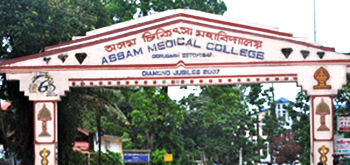Assam Medical College, Dibrugarh is one of the premier and oldest medical institutes of the NE region of India. British Philanthropist Sir John Berry White, a retired brigadier of British army and later the civil surgeon of the erstwhile Lakhimpur district in 1870, contributed his lifetime earning of Rupees Fifty Thousand (present day valuation is more than 50 million of rupees to establish his brain child “Berry White Medical School” in 1900 AD. This school heralded the beginning of Allopathic Medical Education by conferring LMP Diploma in old undivided Assam. In 1938, the Assam Branch of Licentiate Medical Practitioner in its annual meeting under the chairmanship of Lokapriya Gopinath Bordoloi, the then premier of the Congress Govt. of Assam decided to upgrade the Berry White Medical School to a full fledged Medical College, Assam Medical College, Dibrugarh was established in 3rd November 1947, in the erstwhile US Military hospital of the second world war at Borbari, Dibrugarh through a process of up-gradation of Berry White Medical School immediately after independence, inaugurated formally by First chief Minister of Assam, Late Lokopriya Gopinath Bordoloi. The admission of the first batch of students was completed in September 1947 with 6th seats.
Dr. Hem Chandra Baruah was the first principal at Assam Medical College. The hospital wing of the college was formally inaugurated by the then Governor Sri Prakash in February 1948. The outpatient department and many para clinical and clinical department continued to function till 1950 in the former Berry White Medical School, Graham Bazar. All departments and outdoors were shifted to the present AMCH campus at Borbari, only after the great earthquake of Assam in 1950.
Twelve students of the first batch graduated from AMCH under Gauhati University in 1952, same year the Indian Medical Council recognized the degree after inspection of the college and entered in the first schedule.
 The devotion & sincerity of the teachers with calibre recruited from other part of the country laid the strong foundation for the future discipline, academic achievements and progress of AMC. Prof. G. D. Kapoor (Surgery), Prof. P. N. Taneja, Prof. N. Gupta, Prof. B. H. P. Pai (Med), Prof. K. S. Grewal (Pharmacology), Prof. P. C. Nambiar (Surgery), Prof. R. G. Krishnan (O&G) Prof. A. E. Sundersan and Prof. N. C. Dey (Pathology), Prof. R. Bhattacharyya were some of those giants walked through the corridors of the newly established Assam Medical College & Hospital, Dibrugarh. Prof. S. N. Sharma was the first person from Assam to become Professor of Surgery and later became the principal of the College. Post graduate Courses were introduced in 1960 and the first batch of postgraduates in General Surgery and Medicine qualified in 1963. The departments of General Medicine and General Surgery were upgraded in 1965 and 1967 respectively. The devotion & sincerity of the teachers with calibre recruited from other part of the country laid the strong foundation for the future discipline, academic achievements and progress of AMC. Prof. G. D. Kapoor (Surgery), Prof. P. N. Taneja, Prof. N. Gupta, Prof. B. H. P. Pai (Med), Prof. K. S. Grewal (Pharmacology), Prof. P. C. Nambiar (Surgery), Prof. R. G. Krishnan (O&G) Prof. A. E. Sundersan and Prof. N. C. Dey (Pathology), Prof. R. Bhattacharyya were some of those giants walked through the corridors of the newly established Assam Medical College & Hospital, Dibrugarh. Prof. S. N. Sharma was the first person from Assam to become Professor of Surgery and later became the principal of the College. Post graduate Courses were introduced in 1960 and the first batch of postgraduates in General Surgery and Medicine qualified in 1963. The departments of General Medicine and General Surgery were upgraded in 1965 and 1967 respectively.
Assam Medical College since its inception has produced more than 7536 medical graduates. Starting initially with 65 seats, it presently enrolls 170 students into MBBS course every year. Post Graduate classes started in 1962 and till date the college can boast of producing more than 2758 specialists, both degree and diploma holders. At preset average daily attendance of patients in the OPD in AMC is around 1500.
The role of this pioneer medical institute during the past six decades in extending health care services to millions of needy patients is laudable. Besides this, the institute provides medical and paramedical manpower and training to various Governments, industrial and private hospitals of entire North-East region, including faculty development for establishment of new medical colleges.
The contributions made by this premiere medical institute are not only monumental, but also of great significance in the development of modern health care services in the entire North-East region of India.
It is now well on its way for becoming a super specialty medical institution by way of massive up-gradation of its infrastructure with financial assistance from different Govt. and Non-Govt. organizations. |